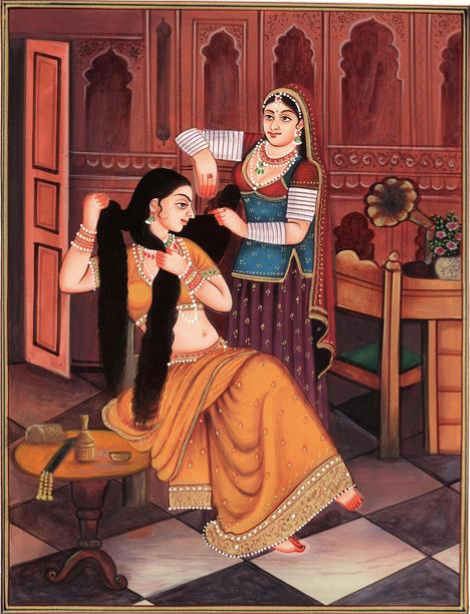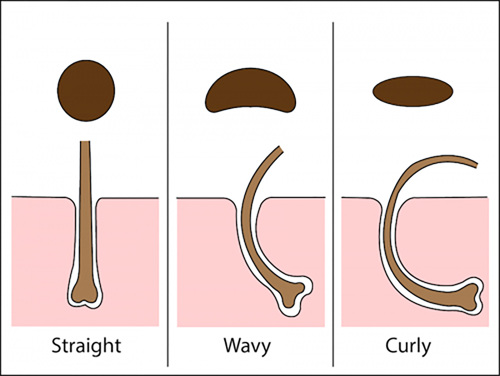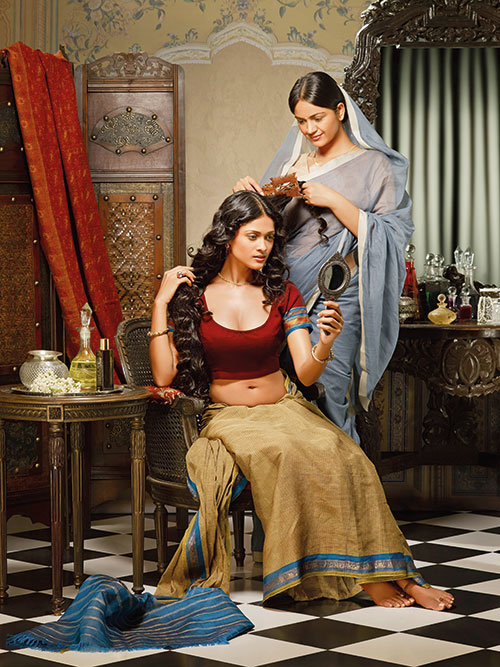Plant Powered Hair Care: The Science & Secrets of Ayurvedic Hair Oiling
 In Ayurveda, there's an old and special way of taking care of hair by using oils. People mix plants and herbs into oils and massage them into the head to help hair grow and solve head skin problems. These oil recipes have been shared in families for a very long time.
In Ayurveda, there's an old and special way of taking care of hair by using oils. People mix plants and herbs into oils and massage them into the head to help hair grow and solve head skin problems. These oil recipes have been shared in families for a very long time.
For thousands of years, people have taken part in rituals to repair, replenish and nourish their hair. A lot of hair care starts with understanding how the hair works - what it’s made of, its structure and its life cycle.
Hair Anatomy
The structure of our hair is made of 2 parts: the follicle and the shaft. The follicle sits at the root of the shaft and is responsible for the growth and health of our hair. It’s a tunnel-like structure with several layers extending through the epidermis and down to the dermis.
The Follicle
We're born with all our hair follicles. These follicles grow hair in the active phase called anagen. About 90% of scalp hairs are in this phase. As hair grows, 2 protective layers surround it. The inner layer stops below the oil gland, but the outer goes around it. This gland makes oil to keep hair healthy. As we get older, less oil is produced, so using natural oil, matching the one produced by the body, helps keep hair strong.
The Shaft
Hair is made of Keratin, a protein with three parts: the medulla (inside), cortex (middle), and cuticle (outside). The cortex forms most of the hair, but the cuticle is crucial for protection (though easily damaged). The cuticle has overlapping tiles that keep moisture in. If damaged, hair can break easily. Since hair's Keratin is dead, we must protect it as it can't self-heal.
The Life Cycle of Hair
Experts say we lose 50-100 hairs daily. Scalp hair's growth phase, anagen, lasts 2-6 years, while eyelashes and eyebrows last 30-45 days. After anagen, hair enters catagen, a 2-week phase where the outer root sheath shrinks and attaches to the shaft (the white material when pulling a hair out). Next, the hair goes into the resting phase, telogen, affecting 6-8% of hairs and lasting 100 days for scalp hair. The cycle restarts, pushing out old hair as new hair grows.
Hair Growth & The Genetics

Pretty much everything about our hair is decided for us by our genetics. For example, even the shape of the hair follicle we’re born with determines how our hair will grow. Round follicles grow straight hair, oval-shaped follicles grow wavy hair and ribbon-shaped follicles will give you curly hair. It’s all about your DNA and genetics. How fast, or long, your hair grows is also determined by genes. If you struggle to grow your hair, this could be because your hair spends less time in its anagen phase. This phase of the hair cycle is the only period of time that the hair will actively grow and get longer – so if your anagen phase is only 2 years long then your hair is likely to ‘max-out’ at a shorter length before the cycle restarts. However, this doesn’t mean you have to sit back and accept your hair fate. The overall condition of our hair and scalp plays a big role in its growth and appearance. The healthier the hair - the longer and stronger it will grow. When it comes to hair care, we can learn a lot from ayurvedic rituals and remedies.
Ancient Hair Care Rituals
The ancient Ayurvedic tradition of hair oiling involves massaging natural, nutrient-rich oils into the scalp and lengths to moisturize, strengthen and thicken the hair. The ritual is as much about hair health as it is about self-care and bonding time with your hair-oiling partner. In fact, in Sanskrit the phrases ‘to oil’ and ‘to love’ share the same word – Sneha. In Indian culture, recipes of infused oils have been handed down from generation to generation to use as part of the hair oiling practice. Traditionally, Sesame Oil is used in the cold season and Coconut Oil in the warm season, but as time has passed the recipes have adapted and evolved. In the GCC, due to abundance of Olive Oil, it is the most favored oil for massage.
Natural & Nourishing Oils
Deeply conditioning the hair with natural oils forms a protective & nourishing layer around the shaft to help it stay free from damage while it grows (helping it to grow longer & stronger).
Hair Healing Herbs
Alongside oils, certain herbs and botanicals have particularly healing qualities when it comes to our hair. These herbs have been used by Ayurvedic practitioners for 5000 years, and they are still proving to be just as effective as any modern, chemical-based treatment. The not-so-secret ingredient in our Hair Exilir is our slow infusion of 12 Ayurvedic botanicals with a combination of 10 Oils. Rich in vitamins, nutrients and fatty acids essential for healthy hair and scalp conditions. Our own in-house blend reinvigorates traditional recipes used for centuries to nourish, soften and repair damaged hair.
Detailed ingredients used in our oil can be found here.

Scalp Massage
Massage has always been an integral part of the Ayurvedic ritual of hair oiling. It helps the oils to penetrate the skin and reach deep into the dermis to nourish the hair at the root. Imagine the skin on the top of your head as the soil which your hair grows from – if the soil is dry and lacking in nutrients, the growth will be slow and weak. The way our hair grows isn’t too different – you can’t have hair health without scalp health. You can use your fingers, a comb, or a micro derma roller to massage the scalp as part of your hair care ritual. The massage disrupts the lower levels of skin to increase blood flow and stimulate hair folicles by activating tiny muscles that contract and cause the hair to stand on end. This contraction causes the sebaceous glands to secrete the oil and sebum needed to nourish the root of the hair helping it to grow healthier, thicker and longer.

In Ayurvedic practices, caring for the hair and scalp comes hand in hand caring for the mind and soul. Scalp massage is traditionally a bonding time between mothers and daughters, and the massage itself is believed to activate the crown chakra – the spiritual bodies centre of wisdom and enlightenment. Just a few moments of scalp massage a day have been proven to reduce tension, headaches, stress and anxiety. Haircare is simple when we embrace the natural goodness of the herbs, seeds, botanicals and flowers that grow in our soils. Reconnecting to the earth and ancient rituals allows us to nurture the self, the scalp and the hair. If you have read this far, thanks for sticking with us. We hope you give Hair Oiling a try and if you do – please let us know how you find the experience.
